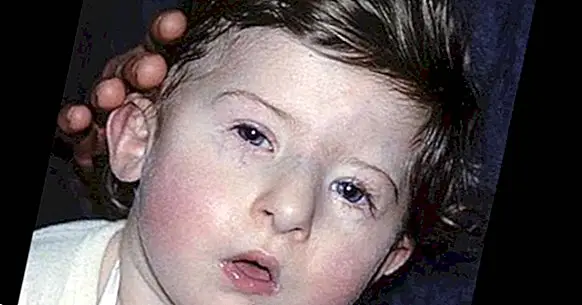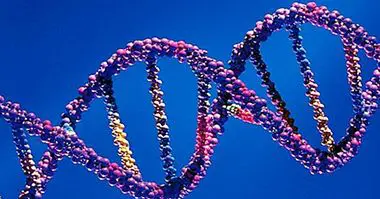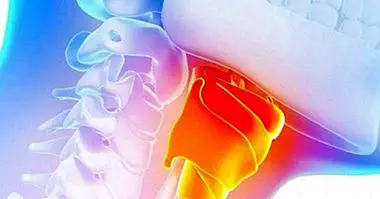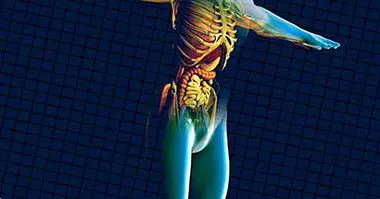DiGeorge syndrome: symptoms, causes and treatment
DiGeorge Syndrome affects the production of lymphocytes and can cause different autoimmune diseases, among other things. It is a genetic and congenital condition that can affect 1 of every 4,000 births, and is sometimes detected until adulthood.
Then we will see what is the DiGeorge syndrome and what are some of its consequences and main manifestations.
- Related article: "The differences between syndrome, disorder and disease"
What is DiGeorge Syndrome?
DiGeorge Syndrome is an immunodeficiency disease caused by an excessive growth of certain cells and tissues during embryonic development . It usually affects the thymus gland, and with this, and the production of T lymphocytes, which has as a consequence the frequent development of infections.
Causes
One of the main characteristics presented by 90% of people diagnosed with this syndrome is that a small part of chromosome 22 (from position 22q11.2., Specifically) is missing. For this reason, Digeorge Syndrome is also known as chromosome deletion syndrome 22q11.2 .
Likewise and for its signs and symptoms, it is also known as Velocardiofacial Syndrome or Abnormal Conotruncal Face Syndrome. The deletion of a fraction of chromosome 22 may be caused by random episodes related to sperm or eggs , and in few cases due to hereditary factors. So far what is known is that the causes are nonspecific.
- Maybe you're interested: "Differences between DNA and RNA"
Symptoms and main characteristics
The manifestations of DiGeorge Syndrome can vary according to the organism itself. For example, there are people who have severe cardiac affectations or some type of intellectual disability and even special susceptibility towards psychopathological symptoms, and there are people who do not present any of this.
This symptomatic variability is known as phenotypic variability , since it depends to a large extent on the genetic load of each person. In fact, this syndrome is considered as a clinical picture with a high phenotypic variability. Some of the most common characteristics are the following.
1. Characteristic facial appearance
Although this does not necessarily occur in all people, some of the facial features of Digeorge Syndrome include a very developed chin, eyes with heavy eyelids, ears slightly turned backwards with part of the upper lobes above them. There may also be cleft palate or poor palatal function .
2. Cardiac pathologies
It is common to develop different alterations of the heart, and therefore of its activity. Generally these alterations affect the aorta (the most important blood vessel) and the specific part of the heart where it develops. Sometimes these alterations may be very mild or may be absent.
3. Alterations in the thymus gland
In order to act as a protector against pathogens, the lymphatic system must produce T cells. In this process, the thymus gland plays a very important role . This gland begins its development in the first three months of fetal growth, and the size that it reaches directly affects the number of T-lymphocytes that develop. People who have a small thymus produce fewer lymphocytes.
While lymphocytes are essential for protection against viruses and for producing antibodies, people with DiGeorge Syndrome have a significant susceptibility to viral, fungal, and bacterial infections. In some patients, the thymus gland may even be absent, which requires immediate medical attention.
4. Development of autoimmune diseases
Another consequence of the lack of T lymphocytes is that can develop some autoimmune disease , which is when the immune system (antibodies) tends to act inappropriately towards the body itself.
Some of the autoimmune diseases caused by DiGeorge Syndrome are idiopathic thrombocytopenic purpura (which attacks platelets), autoimmune hemolytic anemia (against red blood cells), rheumatoid arthritis, or autoimmune thyroid disease.
5. Alterations in the parathyroid gland
The DiGeorge syndrome also can affect the development of a gland called a parathyroid gland (It is located on the front of the neck, near the thyroid). This can cause changes in the metabolism and alterations in the levels of calcium in the blood, with which, the person can present seizures. However, this effect usually becomes less severe as time passes.
Treatment
The recommended therapy for people who have DiGeorge Syndrome is aimed at correcting alterations in organs and tissues. However, and due to the high phenotypic variability, therapeutic indications may be different depending on the manifestations of each person .
For example, to treat alterations of the parathyroid gland, a calcium compensation treatment is recommended, and for cardiac alterations there is a specific medication or in some cases a surgical intervention is recommended. It can also happen that T lymphocytes function normally , whereby, no therapy for immunodeficiency is required. Likewise, it can happen that the production of T lymphocytes increases gradually with age.
In the opposite case, specific immunological attention is needed, which includes constantly monitoring the immune system and the production of T lymphocytes. For this reason, it is recommended that if a person presents recurrent infections without apparent cause, tests are performed to evaluate the entire system. Finally, in the event that the person completely lacks T cells (what may be called "Complete DiGeorge Syndrome"), it is recommended to perform a thymus transplant.
Bibliographic references:
- Aglony, M., Lizama, M, Méndez, C. et al. (2004). Clinical manifestations and immunological variability in nine patients with DiGeorge Syndrome. Medical Journal of Chile, 132: 26-32.
- Immune Deficiency Foundation. (2018). DiGeorge Syndrome. Retrieved June 7, 2018. Available at //primaryimmune.org/about-primary-immunodeficiencies/specific-disease-types/digeorge-syndrome.



















